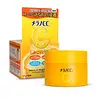What's inside
What's inside
 Key Ingredients
Key Ingredients

 Benefits
Benefits

 Concerns
Concerns

 Ingredients Side-by-side
Ingredients Side-by-side

Butylene Glycol
HumectantAlcohol Denat.
AntimicrobialGlycerin
HumectantCarbomer
Emulsion StabilisingPolyglyceryl-4 Caprate
EmulsifyingPhenoxyethanol
PreservativeCaprylyl Glycol
EmollientTocopheryl Acetate
AntioxidantSodium Hydroxide
BufferingSodium Hyaluronate
HumectantParfum
MaskingSalicylic Acid
MaskingTrisodium Ethylenediamine Disuccinate
Benzyl Benzoate
AntimicrobialRubus Idaeus Juice
AstringentBenzyl Alcohol
PerfumingGeraniol
PerfumingLinalool
PerfumingLimonene
PerfumingHydroxycitronellal
PerfumingSodium Benzoate
MaskingAlpha-Isomethyl Ionone
PerfumingPotassium Sorbate
PreservativeCI 14700
Cosmetic ColorantButylene Glycol, Alcohol Denat., Glycerin, Carbomer, Polyglyceryl-4 Caprate, Phenoxyethanol, Caprylyl Glycol, Tocopheryl Acetate, Sodium Hydroxide, Sodium Hyaluronate, Parfum, Salicylic Acid, Trisodium Ethylenediamine Disuccinate, Benzyl Benzoate, Rubus Idaeus Juice, Benzyl Alcohol, Geraniol, Linalool, Limonene, Hydroxycitronellal, Sodium Benzoate, Alpha-Isomethyl Ionone, Potassium Sorbate, CI 14700
Ascorbyl Glucoside
AntioxidantTocopheryl Acetate
AntioxidantDipotassium Glycyrrhizate
HumectantAscorbic Acid
AntioxidantAlpinia Katsumadai Seed Extract
Skin ConditioningCitrus Limon Fruit Extract
MaskingCornus Officinalis Fruit Extract
Skin ConditioningC4-18 Alkyl Methacrylate/Methacryloyloxyethyl Phosphorylcholine Copolymer
HumectantButylene Glycol
HumectantPentylene Glycol
Skin ConditioningGlycerin
HumectantBifida Polysaccharide
HumectantPentaerythrityl Tetraethylhexanoate
EmollientPPG-17 Butyl Ether
Skin ConditioningPotassium Hydroxide
BufferingPolyvinylalcohol Crosspolymer
Diethoxyethyl Succinate
SolventPEG-8 Dimethicone
EmulsifyingPolyglyceryl-2 Hydroxypropyl Ethylhexyl Ether
CleansingPolyacrylamide
Phenoxyethanol
PreservativeGlyceryl Hydroxystearate
EmollientParaffinum Liquidum
EmollientPEG-20 Sorbitan Isostearate
EmulsifyingSodium Paraben
PreservativeBehenyl Alcohol
EmollientCetearyl Alcohol
EmollientPPG-4 Lauryl Ether
EmollientXanthan Gum
EmulsifyingC16-24 Alkyl C16-24 Acidate
Skin ConditioningAcrylates/C5-8 Alkyl Acrylate Copolymer
Emulsion StabilisingParfum
MaskingAscorbyl Glucoside, Tocopheryl Acetate, Dipotassium Glycyrrhizate, Ascorbic Acid, Alpinia Katsumadai Seed Extract, Citrus Limon Fruit Extract, Cornus Officinalis Fruit Extract, C4-18 Alkyl Methacrylate/Methacryloyloxyethyl Phosphorylcholine Copolymer, Butylene Glycol, Pentylene Glycol, Glycerin, Bifida Polysaccharide, Pentaerythrityl Tetraethylhexanoate, PPG-17 Butyl Ether, Potassium Hydroxide, Polyvinylalcohol Crosspolymer, Diethoxyethyl Succinate, PEG-8 Dimethicone, Polyglyceryl-2 Hydroxypropyl Ethylhexyl Ether, Polyacrylamide, Phenoxyethanol, Glyceryl Hydroxystearate, Paraffinum Liquidum, PEG-20 Sorbitan Isostearate, Sodium Paraben, Behenyl Alcohol, Cetearyl Alcohol, PPG-4 Lauryl Ether, Xanthan Gum, C16-24 Alkyl C16-24 Acidate, Acrylates/C5-8 Alkyl Acrylate Copolymer, Parfum
Alternatives
Ingredients Explained
These ingredients are found in both products.
Ingredients higher up in an ingredient list are typically present in a larger amount.
Butylene Glycol (or BG) is used within cosmetic products for a few different reasons:
Overall, Butylene Glycol is a safe and well-rounded ingredient that works well with other ingredients.
Though this ingredient works well with most skin types, some people with sensitive skin may experience a reaction such as allergic rashes, closed comedones, or itchiness.
Learn more about Butylene GlycolGlycerin is already naturally found in your skin. It helps moisturize and protect your skin.
A study from 2016 found glycerin to be more effective as a humectant than AHAs and hyaluronic acid.
As a humectant, it helps the skin stay hydrated by pulling moisture to your skin. The low molecular weight of glycerin allows it to pull moisture into the deeper layers of your skin.
Hydrated skin improves your skin barrier; Your skin barrier helps protect against irritants and bacteria.
Glycerin has also been found to have antimicrobial and antiviral properties. Due to these properties, glycerin is often used in wound and burn treatments.
In cosmetics, glycerin is usually derived from plants such as soybean or palm. However, it can also be sourced from animals, such as tallow or animal fat.
This ingredient is organic, colorless, odorless, and non-toxic.
Glycerin is the name for this ingredient in American English. British English uses Glycerol/Glycerine.
Learn more about GlycerinParfum is a catch-all term for an ingredient or more that is used to give a scent to products.
Also called "fragrance", this ingredient can be a blend of hundreds of chemicals or plant oils. This means every product with "fragrance" or "parfum" in the ingredients list is a different mixture.
For instance, Habanolide is a proprietary trade name for a specific aroma chemical. When used as a fragrance ingredient in cosmetics, most aroma chemicals fall under the broad labeling category of “FRAGRANCE” or “PARFUM” according to EU and US regulations.
The term 'parfum' or 'fragrance' is not regulated in many countries. In many cases, it is up to the brand to define this term.
For instance, many brands choose to label themselves as "fragrance-free" because they are not using synthetic fragrances. However, their products may still contain ingredients such as essential oils that are considered a fragrance by INCI standards.
One example is Calendula flower extract. Calendula is an essential oil that still imparts a scent or 'fragrance'.
Depending on the blend, the ingredients in the mixture can cause allergies and sensitivities on the skin. Some ingredients that are known EU allergens include linalool and citronellol.
Parfum can also be used to mask or cover an unpleasant scent.
The bottom line is: not all fragrances/parfum/ingredients are created equally. If you are worried about fragrances, we recommend taking a closer look at an ingredient. And of course, we always recommend speaking with a professional.
Learn more about ParfumPhenoxyethanol is a preservative that has germicide, antimicrobial, and aromatic properties. Studies show that phenoxyethanol can prevent microbial growth. By itself, it has a scent that is similar to that of a rose.
It's often used in formulations along with Caprylyl Glycol to preserve the shelf life of products.
Tocopheryl Acetate is AKA Vitamin E. It is an antioxidant and protects your skin from free radicals. Free radicals damage the skin by breaking down collagen.
One study found using Tocopheryl Acetate with Vitamin C decreased the number of sunburned cells.
Tocopheryl Acetate is commonly found in both skincare and dietary supplements.
Learn more about Tocopheryl Acetate